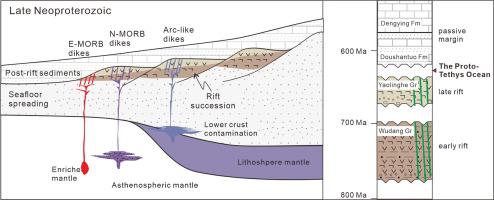Gondwana Research ( IF 7.2 ) Pub Date : 2021-08-09 , DOI: 10.1016/j.gr.2021.06.023 Hang Liu 1, 2 , Jun-Hong Zhao 2 , Long-Ming Li 1

|
Magmatism in the passive margin records continuum rift of continental lithosphere and onset of seafloor spreading. The ca. 650 Ma ultramafic-mafic dike swarms are the latest magmatic episode in the South Qinling Belt during the Neoproterozoic, and therefore provide a window to address their mantle sources, and the continental rift to drift transition. These mafic dikes have distinct geochemical signatures, and can be grouped as N-MORB-, E-MORB-, and Arc-affinities. The Shiziyan amphibole gabbros have low Rb/Y (<0.75), Nb/Y (<0.15), Nb/Zr (<0.05), Th/Zr (<0.01) ratios, positive εNd (+4.3 to +5.4), low Sri (0.70650–0.70759) and moderate 207Pb/204Pb (15.48) and 206Pb/204Pb (17.57), similar to N-MORB, suggesting that they were derived from an asthenosphere mantle. The Yindongshan pyroxenites display enrichment of LILEs and HFSEs, similar to the E-MORB characters. They also have low Sri (0.70384–0.70410), high εNd (+4.2 to +5.4), and 207Pb/204Pb (15.53–15.54) and 206Pb/204Pb (18.18–18.37). They have high zircon εHf (+13.1 to +15.0), but low δ18O values (+4.43 to +5.17‰). These chemical features indicate an enriched mantle source with involvement of recycled component. The Duchongshan olivine gabbros show arc-like geochemical features, with high Nb/Zr (0.07–0.16), Nb/Yb (3.52–20.1) ratios, and high Sri (0.70545–0.70586), negative εNd (−6.1 to −5.2), large variable zircon εHf (−0.5 to +4.2) and high δ18O (+5.41 to +6.41‰). These features favor that they were derived from a subduction-modified lithosphere mantle followed by significant crustal contamination. The northern Yangtze Block experienced secular crustal extension and developed into a volcanic rift margin during the middle to late Neoproterozoic. Mafic dike swarms emplaced into the volcanic successions and unconformably overlayed by late Ediacaran neritic to abysmal deposition. The magmatic termination and sedimentary facies transition indicate that the northern Yangtze Block broke up during the late Neoproterozoic and the Proto-Tethys Ocean opened at ca. 650 Ma.
中文翻译:

原特提斯洋的张开:来自华南南秦岭带晚新元古代基性岩脉群的启示
被动边缘的岩浆活动记录了大陆岩石圈的连续裂谷和海底扩张的开始。约。650 Ma超基性-基性岩脉群是新元古代南秦岭带最新的岩浆事件,因此为解决其地幔来源和大陆裂谷向漂移过渡提供了一个窗口。这些基性岩脉具有不同的地球化学特征,可分为 N-MORB-、E-MORB- 和 Arc-亲和性。十子岩闪闪辉长岩具有低 Rb/Y (<0.75)、Nb/Y (<0.15)、Nb/Zr (<0.05)、Th/Zr (<0.01) 比值,正 εNd(+4.3 至 +5.4),低Sr i (0.70650–0.70759) 和中等207 Pb/ 204 Pb (15.48) 和206 Pb/ 204Pb (17.57),类似于 N-MORB,表明它们来自软流圈地幔。银洞山辉石显示出 LILEs 和 HFSEs 的富集,类似于 E-MORB 的特征。它们还具有低 Sr i (0.70384–0.70410)、高 εNd (+4.2 至 +5.4),以及207 Pb/ 204 Pb (15.53–15.54) 和206 Pb/ 204 Pb (18.18–18.37)。它们的锆石 εHf 较高(+13.1 至 +15.0),但 δ 18 O 值较低(+4.43 至 +5.17‰)。这些化学特征表明地幔来源丰富,涉及回收成分。独冲山橄榄辉长岩呈弧形地球化学特征,具有高Nb/Zr(0.07-0.16)、Nb/Yb(3.52-20.1)比值和高Sr i(0.70545–0.70586),负 εNd(-6.1 到 -5.2),大变锆石 εHf(-0.5 到 +4.2)和高 δ 18 O(+5.41 到 +6.41‰)。这些特征表明它们来自俯冲改造的岩石圈地幔,随后发生了显着的地壳污染。扬子地块北部在新元古代中晚期经历了长期地壳伸展,发育为火山裂谷边缘。基性岩脉群进入火山序列,并被晚期埃迪卡拉纪浅海至深渊沉积不整合地覆盖。岩浆终止和沉积相转变表明,北扬子地块在新元古代晚期破裂,原特提斯洋在约 650 毫安。











































 京公网安备 11010802027423号
京公网安备 11010802027423号